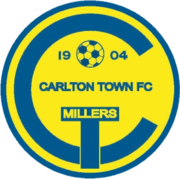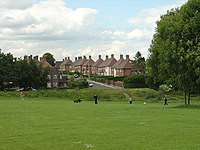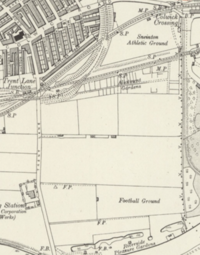
Notts County Football Club is a professional association football club based in Nottingham, England. The team compete in EFL League Two, the fourth level of the English football league system, as of the 2023–24 season. Founded on 28 November 1862, it is the oldest professional association football club in the world and predates the Football Association itself. The club became one of the 12 founder members of the Football League in 1888. They are nicknamed the "Magpies" due to the black and white colour of their home strip, which inspired Italian club Juventus to adopt the colours for their kit in 1903. After playing at different home grounds during its first fifty years, including Trent Bridge, the club moved to Meadow Lane in 1910 and remains there. Notts County has a local rivalry with city neighbour Nottingham Forest, as well as with other nearby clubs such as Mansfield Town.

The Amateur Football Alliance is a county football association in England. It is unusual among county FAs in not serving a particular geographical area. It was founded in 1906 as the Amateur Football Defence Council, was briefly known as the Amateur Football Defence Federation, and was reformed as the Amateur Football Association in 1907, when The FA required all county associations to admit professional clubs. Its aim was, as the decline of amateurism at the highest levels of football set in, to protect and preserve the original amateur spirit. It prides itself on the skill and competitiveness of its leagues, and on its traditions of fair play and respect for opponents and match officials. Many leagues still maintain rules that require clubs to provide food and drink to their opponents and match officials after the match in a clubhouse or public house.

Carlton is a town in the Borough of Gedling, Nottinghamshire, England. It is to the east of Nottingham. The population at the 2011 Census was 6,881. It was an urban district until 1974, whose wards had an estimated population of 48,416 in 2015. Owing to the growth of residential, commercial and industrial in the wider Gedling Borough, City of Nottingham, Borough of Broxtowe, Rushcliffe and Ashfield District, as well as the Amber Valley and Borough of Erewash in Derbyshire which have become quite urban around Nottingham, Carlton and Gedling, as well as Netherfield form a contiguous urban area.
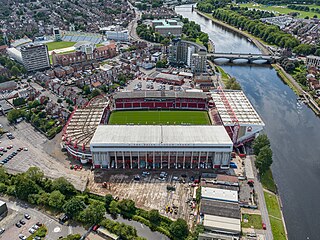
The City Ground is a football stadium in West Bridgford, Nottinghamshire, England, on the banks of the River Trent. It has been home to Nottingham Forest since 1898 and has a capacity of 30,455.

Sneinton is a suburb of Nottingham and former civil parish in the Nottingham district, in the ceremonial county of Nottinghamshire, England. The area is bounded by Nottingham city centre to the west, Bakersfield to the north, Colwick to the east, and the River Trent to the south. Sneinton lies within the unitary authority of Nottingham City, having been part of the borough of Nottingham since 1877.
Bakersfield is a small residential suburb of Nottingham east of the city centre.
William John Wheeler was a professional footballer who played as a goalkeeper for Cheltenham Town, Birmingham City, Huddersfield Town and Kettering Town. He helped Huddersfield Town to promotion to the First Division, and played more than 150 matches in the Football League for the club. After his playing career finished, he spent more than 25 years with Notts County, in a variety of roles including coach, trainer, caretaker manager and scout.
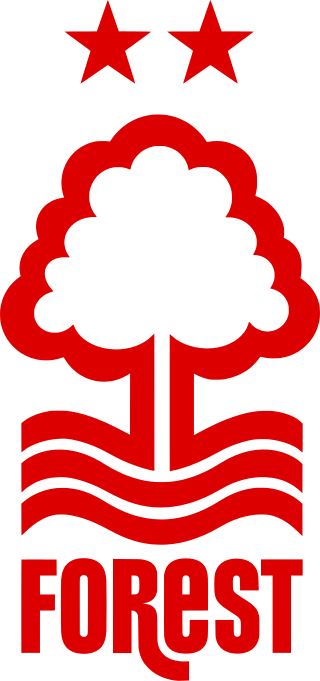
Nottingham Forest Women Football Club is an English women's association football club affiliated with men's Nottingham Forest. It is a member of the FA Women's National League North, which stands at level three of the women's football league pyramid.
Frederick William Banks was an English professional footballer who made 72 appearances in the Football League playing for Birmingham and Nottingham Forest. He played as an outside forward.

Robert Hewison was an English footballer who filled various roles on the left of the pitch before going on to make his name as a manager.
Frederick Laidman was an English footballer who played as an inside forward in the Football League for Bristol City and Darlington. He was on the books of Burnley and Everton without representing them in the League, was registered with Sunderland during the Second World War, and played non-league football for Crook Town, Wigan Athletic and Stockton.
Albert Edward Bonass was an English footballer who scored 58 goals from 186 appearances in the Football League playing as an outside left for Darlington, York City, Hartlepools United and Chesterfield.
William Oxley was an English footballer who played as a centre forward in the Football League for Rochdale, Southport, Merthyr Town, Northampton Town, Durham City, Darlington and Carlisle United. He was on the books of Middlesbrough, Manchester City and Wigan Borough, without playing League football for any of them, and also played non-league football for Percy Main Amateurs, Wallsend Athletic, Walker Celtic, Consett and Blyth Spartans.
Alfred Dolphin was an English footballer who made 97 appearances in the Football League playing as an outside right for Oldham Athletic, Notts County, Darlington, Stockport County and Walsall. He also played non-league football for clubs including Redditch, Nuneaton Town and Weymouth.

Richard Healey was an English footballer who played as an inside right or centre forward in the Football League for Sunderland, Middlesbrough and Darlington.
Francis Raymond O'Connor, generally known as Raymond O'Connor but also as Frank O'Connor, was an English footballer who played as a right half in the Football League for Mansfield Town and Darlington. He was on the books of Portsmouth without playing League football for them, and also played non-league football for Jarrow and Gillingham.
John Westness Downing was an English amateur footballer who played in the Football League for Darlington. He played non-league football for Evenwood Town, Spennymoor United, Stockton and Shildon. He played either at inside left or centre forward.
Notts Olympic Football Club was an English football club from the Radford district of Nottingham.
Jardines F.C. was an English association football club from Nottingham, England.
